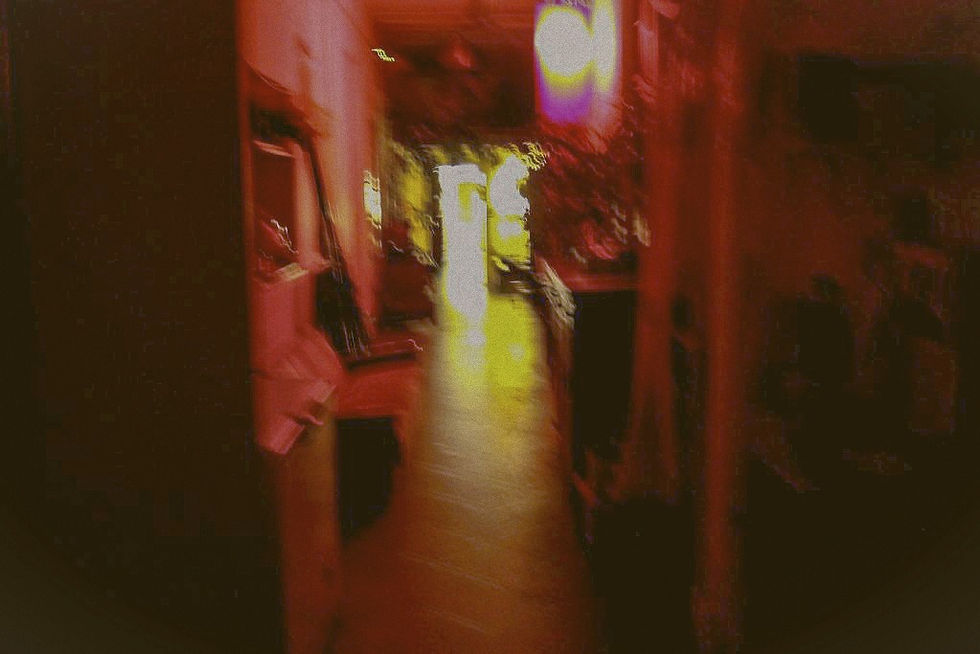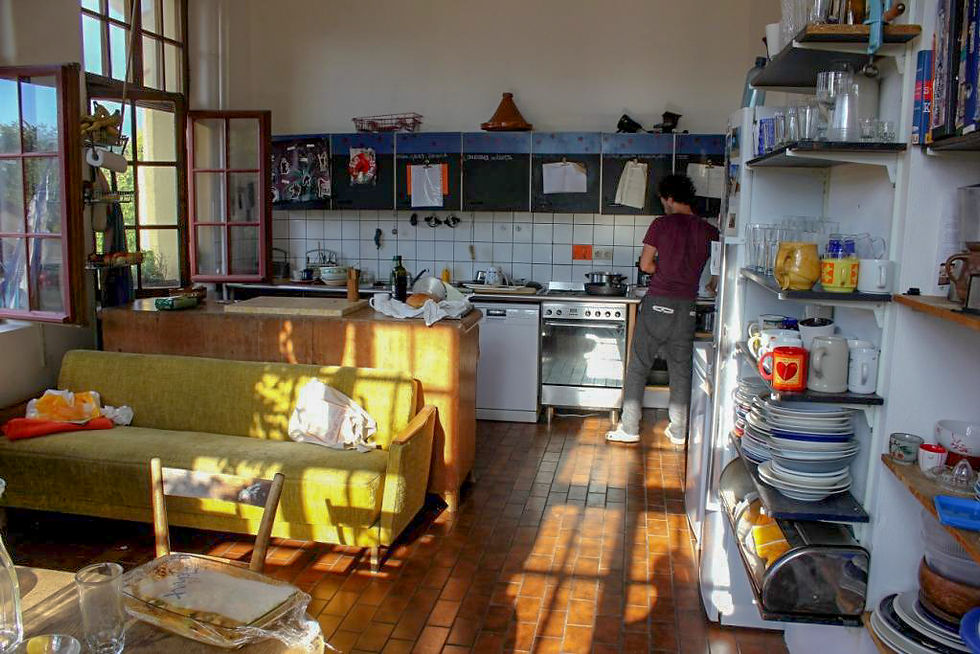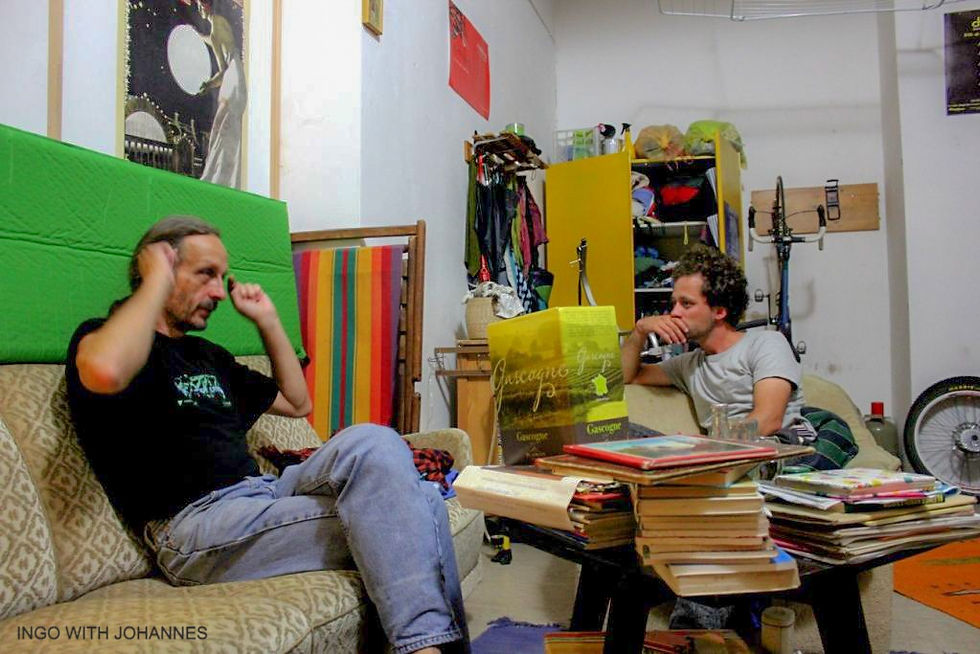BY MIHIR SRIVASTAVA
It was the midnight of August 16 when I entered here. My friend, Johannes, a PhD candidate at Tübingen University, was the host. His room was on the first floor of the building’s left flank.
The door opened to a long corridor that seemed endless, converging to a point, illuminated by the dim light of a dull yellow bulb. I felt disoriented.
“You live here?” I asked my friend in disbelief, “This is so big, too big to be homely.” It looked like the barracks in an old castle.

Johannes took me for a quick guided tour. Along the corridor were four rectangular halls, one after the other. Each hall opened into three rooms, so there are 12 rooms that housed 12 distinctively different people. At the far end of the long corridor are the common bathrooms. Bathing spaces were segregated by shower curtains that were not pulled.
Johanne’s room was in the first hall just as you enter. Which meant that it was a long walk to the bathrooms from his room. The kitchen-cum-dining space was across the corridor in front of his hall. It’s a big rectangular room with a long cooking slab on one side and a counter in the middle separating the kitchen from the dining area.
The open shelves in the kitchen has cups, glasses and utensils procured at various points in time by various residents of the house. Every item on the shelf seems to have a history attached to it. Like this bust of an old man that sits oddly with the rest of the utensils; it bears a wrinkled face with an imperial moustache, and no one knows who he was and what was hist bust doing here. I was tempted to believe it’s the bust of French army officer who might have had his men living here at some point, but I was told that this was unlikely since the sculpture was not as old as it looked.
A large dining table where people came at different points in time to get fed, there was always company. There were times they ate without indulging in a conversation. This doubled as a common room where residents read periodicals and played board games.
The large windows of the kitchen overlooked the backyard. Sitting in the kitchen you can watch the backyard café nestled in the garden where plants and grass is allowed to grow wild.
Further down, tucked underneath a tree there is a huge iron cylindrical boiler with a ladder alongside. On winter nights, this boiler is filled with water and heated with charcoal for residents to slip in neck-deep, soak in the warmth and chat up over a drink or two. It is large enough to accommodate a dozen people at a time.
The corridor has a few lofts and one of them was converted into an elevated guest room for my four nights here. The first night in my special bunk, I had a vivid dream–of my watching a vintage film on a black-and-white television screen. I felt a wetness on my face, and when I opened my eyes in the dream, I found three dogs licking my face. Next, if I recall correctly, I dreamt of a white curtain with a floral print hanging loose before my eyes with what seemed like a naked woman standing behind it. I got up in my dream to pull the curtain and felt someone held me by neck to strangulate —and I was nearly choked to death by the time I woke up. It was the fault of the bust, I sensed.
I thought of waking Johannes up to declare that this place is haunted. That’s imbecility, I reasoned. This is just a dream. I can’t announce to the world that I’m chicken scared of a dream. I did manage to get some rest.

The morning sun transformed the whole place, it looked so much more agreeable. I loved the old sofas with soiled upholstery. I saw a nearly naked woman pass by from the vantage position I was lying in harbinger of an unknown adventure. The wooden shelves of solid wood stood majestically by the long walls of the corridor. The full volumes of an encyclopaedia were neatly lined on a shelf carved out of the wall. Much of the furniture had been procured second-hand, and some of it might have been as old as the building itself, which was built in 1914.
The Shelling Project is the official name, and we’d address it as Shelling, buys household provisions, puts the food on the table, is the host to many parties, and runs a café in the basement and the other in the backyard.
Johannes called it the 'home', and as it turns out is an artificial person for all practical purposes. Perhaps, of the third gender, free from binaries, yet conservative in some senses, is the legal owner of property, gadgets and furniture, that shelters and feeds its owners—120 of them—who live in it and pay for its upkeep.

Shelling is big and accommodative--is a double-storey building that extends about a hundred metres across, like hands spread out to embrace—giving it the look of the main block of a school.
All residents have an equal right over it and encouraged to use it in a way that doesn’t hinder others from using it. A sort of congenial coexistence. Each of them are also co-owner, in other words, ownership is diffused. In effect, all are owners, but no one really controls it.
If Shelling is the mother, or father, or both in some measures, all those who reside are brothers, sisters, lovers, friends with or without benefits. An extended 'Modern" family!
This is not the only commune in the city of Tübingen—a university town nestled in the green hills between two rivers in Southern Germany. Though Shelling is by far the oldest of them.
It's a bit of a mystery how it is run so efficiently. Residents are of varied age groups, and of all hues and descriptions, love and care for it.
Shelling has 10 flats, each with multiple rooms. There are a few inhibiting it for decades, some from the very beginning. They are all part of a committee that runs Shelling, and it gives them a single voice.
On a periodical basis, for a week at one go, all are assigned a routine task or chore to perform to have Shelling running. Instead of paying a monthly rent, they--the owners--contribute a fixed amount for the maintenance and upkeep, and purchase of provisions on a monthly basis.
They retain the membership of the committee as long as they live here or die, whichever happens earlier. When they leave, relinquish their ownership in the favour of the one who replaces them. A newcomer is carefully picked by the committee. And no one can sell the property, individually or collectively, to another private party. So Shelling is not allowed to commit suicide. How can it commit suicide given it has 120 lives at any given time?
The basement has a community hall where residents gather to discuss issues, make decisions on how to run the commune and hold parties. On the other side of the basement in another damp hall, old clothes were neatly hung in parallel rows of metal bars. I thought it’s the laundry room. But Johannes informs me this is where residents leave perfectly usable stuff that is of no use to them for others to make good use of it. There were assorted gadgets, tools, an old camera-and-tripod, artefacts, pottery items, a kettle without a lid and a host of other interesting things. I wanted to carry so many items but picked a pouch to hold pencils.
I watched two young men make graffiti on the entrance door. They were together at it, frantically. Those reckless strokes soon acquired a form. Lines were aggressive and their message revolutionary. They were restless in their skin. They wanted a change they do not know what. They were not okay with the present. Watching them gave me some composure.
Some of the other oddities are striking—like internet use is highly regulated here. It takes elaborate paperwork to get online, a process that was enforced after the police recently descended here in pursuit of someone who had allegedly downloaded child pornography. They could not identify who that person was. But the Shelling was under watch. I used Johannes’ computer to check my email and upload pictures on Facebook. “No child pornography,” he cautioned.

Schelling came into being as an offshoot of the squatter movement of the late 70s and early 80s, when student activists, punks and artists raised their voices against private ownership and began squatting in abandoned buildings, taking them over to create shared living spaces where they could lead an alternate lifestyle inspired by the ideals of sharing and communism and opposed to the authority of ownership and capitalism.
To fund this lifestyle, they took to running unlicensed nightclubs, restaurants, bars and bookstores, even theatres and radio stations to propagate their movement. With their rhetoric of equality, peace and brotherhood, they captured many an imagination of the youth of the day.
The Squatter movement did cause some unrest, particularly in places closer to Berlin like Potsdam. Street battles were fought with the authorities and the squatters were evicted from many places. But the movement survived in places like Tübingen, a beautiful old town of young people, borders forests that open into a wide plateau with apple orchards, lovely meadows that have daffodils all through summer and large farms where humongous tractors plough fields tirelessly. The movement did not last long; as some critics say, it was hurt by its own success.
The building remained abandoned for decades after the French military vacated it post World War II. The squatters occupied it in 1981. Four years later, they signed a rent agreement with the local authorities for 15 years. The squatters became tenants of a cheap accommodation and wanted to keep it that way.
It’s clear that the original ideals were given up a long time ago. Shelling I’m afraid to say is a fair-weather friend. Residents may stay only so long as they have the money to pay their contribution. “And when they can’t, they have to leave,” says Ingo, who has been living here long before Johannes was born. Money matters!

ความคิดเห็น